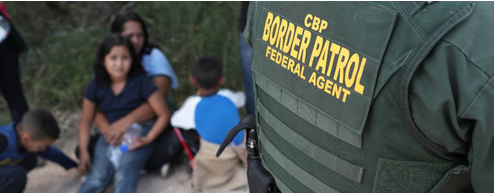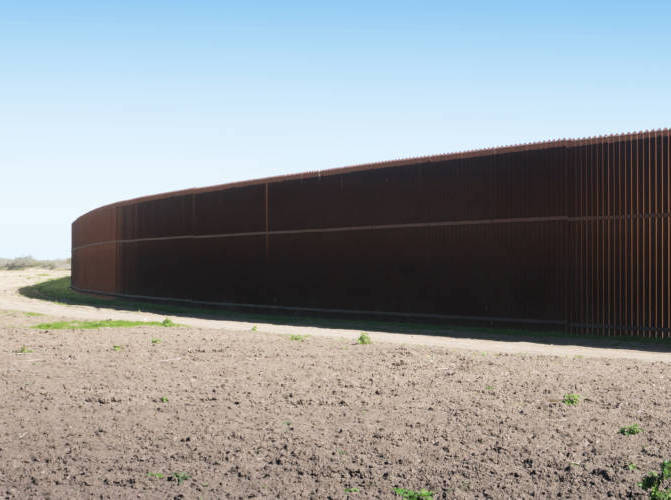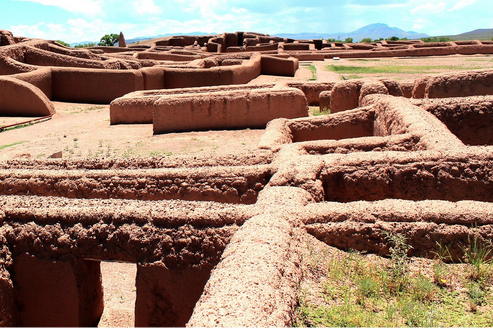
Central American asylum seekers wait as U.S. Border Patrol agents take them into custody on June 12, 2018 near McAllen, Texas. (Photo by John Moore/Getty Images)
Ana Luna tells me that, if she listens to the recordings released by ProPublica of 10 Central American children, it will make her “vomitar.”
“Just watching the news makes me relive what happened to me in that prison,” says Luna, a 30-year-old mother from El Salvador whose name has been changed. Luna, who now lives in Los Angeles, was imprisoned at the Karnes Family Detention Facility between 2014 and 2015 after arriving from El Salvador. Originally a men’s facility, Karnes was built in 2012 by the Obama Administration as the first-ever “civil detention center,” before being turned, in July 2014, into the ICE Family Residential Center to house over 500 of the tens of thousands of Central American women and children seeking asylum.
“I know what those mothers are going through,” she continues. “They [guards at Karnes] threatened to separate my boy from me. I told them I would fight them until they stopped or until they killed me.”
When she feels able to, however, Luna tries to follow the television news about the Trump administration’s child separation policies. She’s paid especially close attention to the firestorm following Attorney General Jeff Sessions’s announcement of the “zero tolerance” policy, which she says only formalized the US government’s practice of separating thousands of Central American children from their mothers. Hearing about those screams second-hand, she says, is “enough.”
Luna’s response to recent reporting on child separation is a mix of relief that the issue is getting more coverage and criticism for “all the things that are missing.” She takes issue with the media’s repetition of the word “detention center” to describe the facilities refugee children and mothers are held. “It’s just a fachada [facade],” she says. “They’re prisons. We had to live for more than a year behind giant walls; we had roll call everyday; we ate food that looked like dog vomit; we had surprise searches in the middle of the night and got isolated and we were threatened with having our children taken away from us when we protested how they treated us.”
What’s changed, according to Luna, is that the media is no longer reporting favorably on the president: “They are criticizing the president and how he’s treating those mothers and their children—and that’s good.” However, she adds, “they’re still missing most of the story of what it’s really like. They’re talking about this like it’s new, as if what happened to us did not happen. You can’t cover the sun with one finger.”
Luna’s analysis is shared widely by scholars, advocates, and journalists who have worked on child refugee and related issues for decades. All agree that both the amount of coverage and the intensity of the emotions that coverage inspires are unprecedented. Depth and accuracy are another story entirely.
Much of the national coverage—on-the-ground reports, think pieces, features, op-eds—about the child refugee crisis in print and electronic media makes it appear as though the crisis is “new,” detached from precursors to Trump’s more formal child separation policy and the recent history of US political and economic involvement in the “Northern Triangle” region—the area including Honduras, Guatemala, and El Salvador that contributes the overwhelming majority of the current influx of asylum seekers at the heart of the child separation story. Instead, coverage focuses on sometimes-exploitative stories of child victims and their distraught mothers, contains an extraordinary amount of stereotypes, and suffers from a dearth of experts who have dedicated their lives to studying the crisis.
“I watch the news and I don’t see any of the people who’ve been writing on these issues for decades,” says Leisy Abrego, an Associate Professor in Chicana/o Studies at UCLA and author of two books on child refugees, including the award-winning Sacrificing Families: Navigating Laws, Labor, and Love Across Borders. “It’s like those women and children don’t have their own stories, their own particular communities with very particular realities —and like there aren’t those of us who’ve been committed to understanding this for a long time.”
In many cases, non-partisan experts with deep knowledge of the many dimensions of the child separation issue are replaced in many stories with political operatives or generic substitutes—or both. Instead of including Central Americans, much national coverage provides extended time and talking space to Obama surrogates. Jeh Johnson, Eric Holder, Michelle Obama, former Deputy Assistant Attorney General Leon Fresco, and other ex-Obama officials are positioned in stories as experts on immigration policy, critics of Trump, or in defense of their administration: “We detained them together. We didn’t separate them,” or “I could not separate a child from her mother in that way,” or “And so we said on that line of morality is we’re not going to separate them.”
On Sunday, The Daily Beast scrutinized the one-dozen guests on five morning shows. “All of them were male and only one of those men is Hispanic.” But what good is a Latino politician when the voices of people at the border, of experts, and of leaders from their large communities in the US are erased? “Generic ‘Latinos’ with no history on these issues replace actual Salvadorans, actual Hondurans and actual Guatemalans from the communities that are most impacted by these policies,” says Abrego. This erasure, she believes, turns the children, their mothers, and their entire communities into objects devoid of agency in the reporting, except for being the voices and faces of profound suffering.
A search of dozens of stories and op-eds about the child separation crisis in print and electronic media yielded no prominent Central American scholars or advocates—despite the fact that the most recent available data from Customs and Border Protection, the Office of Refugee Resettlement, and other government sources show that an overwhelming majority of detained families and unaccompanied minors are Central American. CJR reached out to several of the country’s leading scholars on child refugees and other issues in the child-separation story. With the exception of Abrego, not a single one of the Central American scholars or advocates reached by CJR had been contacted by any major news organizations.
“The BBC called me to set up an interview” she tells CJR, “but they never called me back.” (The BBC did not respond to request for comment.) Abrego, who came as an undocumented five-year-old girl to the United States during the first major wave of Central American migration caused by the wars of the 1980s, is able to combine historical expertise with personal experience. The national media, she says, “present pain for mass consumption, but without any context.”
One of the more glaring errors Abrego and others describe involves the now-iconic picture of a two-year-old Honduran girl crying while her mother was being searched and detained in McAllen, Texas. The photograph, taken for Getty Images on June 12 by Pulitzer Prize-winning photographer John Moore, appears in countless stories and has come to symbolize the separation of families at the center of the national controversy. After Time magazine placed the image of the Honduran girl next to an image of Trump, arranged so he towers over her on the cover of a recent issue titled “Welcome to America,” Customs and Border Protection officials confirmed that the child was not, in fact, separated from her mother. (Time’s editor defended the cover this weekend, saying through a spokesperson, “The [photo of the] Honduran girl became the most visible symbol of the ongoing immigration debate in America for a reason… Our cover and our reporting capture the stakes of this moment.”) The Time cover and the controversy that ensued illustrates the cookie-cutter approach taken by the media on immigration. The media often turns Central American children and mothers into objects that can be cut-and-pasted (in this case, literally) to fit editorial strategies that are often less about Central Americans than about making a political argument—either attacking Trump or defending the Obama administration’s policies.
The best reporting on family separation comes from outlets that aren’t afraid of reporting on how the Obama administration paved the way. Vox’s Dara Lind and Democracy Now’s Renee Feltz, who have both covered these issues for several years, write about a continuum between the Obama and Trump administration practices of child separation. Univision and Telemundo, too, report the child separation issue as a continuation of the crisis they’ve long reported on—and their local and national reporting include Central Americans.
It was wrong when Obama detained immigrant families in jail/cages (2014) and it is wrong now with @realDonaldTrump
There are humane alternatives for children and refugees. Do we want to be known as the country that puts foreign kids in cages? Trump: that’s your place in history https://t.co/Nad72UCIGm
— JORGE RAMOS (@jorgeramosnews) June 23, 2018
But plenty of other coverage avoids criticizing previous administrations. As a result, many reports leave out important information while blurring or erasing the continuum of practices and policies that lead from Bush to Obama to Trump.
Numerous articles and reports followed the pattern of a June 19 report in The Washington Post by Nick Miroff and Sari Horwitz, “Trump didn’t invent family separation, but his administration was willing to try it.” The headline gives the impression that Obama administration was not “willing to try it.” The article quotes Jeh Johnson and other Obama officials recounting how their administration briefly considered a more formal family-separation policy, but ultimately determined such recommendations to be “excessive.” Johnson’s predecessor at Homeland Security, Janet Napolitano, repeated the story in the LA Times, but concluded “pretty quickly that it would be a bad idea.” This is not the case. According to a thorough investigation by Race Forward, a racial-justice think tank, for example, Obama’s policies resulted in more than 5,100 children separated from their imprisoned immigrant parents in 2011 alone, and who were “also denied the ability to meaningfully participate in their court-ordered reunification plans.” Not to mention the fact that all the stories about a protest led by former Obama Housing and Urban Development Secretary Julian Castro at the MacAllen prison facility for children and mothers neglected to mention the facility was built by the Obama administration.
For comparison, look at this June 22 piece, “Yes, Obama separated families at the border, too,” by McClatchy’s Francisco Ordonez and Anita Kumar. Their reporting makes clear how Trump formalized what had been an informal but widespread practice under Obama. Here are the opening sentences:
President Barack Obama separated parents from their children at the border. Obama prosecuted mothers for coming to the United States illegally. He fast tracked deportations. And yes, he housed unaccompanied children in tent cities.
The lack of context in much of the reporting also concerns Abel Núñez, Executive Director of the Central American Resource Center (CARECEN) in Washington, DC. “The stories shift responsibility for migration from the states that failed them to the parents as victims,” he says. “No one talks about the failure of US security, [the] drug war, and economic policies that are the primary drivers of migration, along with gang violence.” (Disclosure: The author of this story was the executive director of the Central American Resource Center in Los Angeles, a separate organization, in the ’90s, and did other pro-immigrant advocacy work between 2009 and 2014.)
To illustrate this discrepancy, Núñez points to a CNN story in late May linking US-funded police to 43 extrajudicial murders in El Salvador. CNN then started covering family separation, he says, “but at no moment do they connect coverage of families at the border to this violence.” Asked what he thinks of the effect of a lack of representation and context in the reporting, Núñez resorts to Spanish for an answer: “Lo que los ojos no ven el corazon no siente”—what the eyes don’t see, the heart doesn’t feel.
Luna also sees the very human effects of the limits of the coverage. “The news makes it seem like we’re criminals that Trump is punishing” she says, her voice trembling. Luna would prefer coverage of the issue that depicts women and children with greater complexity. Referring to the women jailed in Karnes with her, Luna says with pride, “We and our children fought back. We organized a hunger hunger strike, refused to be force-fed [they did continue to feed the children], made protest signs with crayons and markers and we sent letters to President Obama and his wife.” She adds, “Even though we were always being threatened with separation.”
“The [child imprisonment and separation] story is coming out more,” she says, “but it’s also important to know the side [of us] that fought against all this.”




